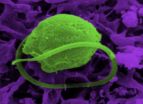(Press-News.org) A combination of anti-HIV drugs has been found to also reduce the risk of recurrent malaria by nearly half among HIV-positive children, according to researchers supported by the National Institutes of Health.
The combination of protease inhibitors lopinavir and ritonavir contributed to an overall reduction of 40 percent in the rate of malaria among a group of HIV-positive infants and children up to 6 years old in Uganda who were also being treated with anti-malarial drugs. This reduction was in comparison to malaria incidence among children receiving a drug treatment of one of a class of drugs called non-nucleoside reverse transcriptase inhibitors (NNRTIs).
Protease inhibitors interfere with the reproduction of HIV by blocking the protease enzyme of HIV. The protease inhibitor combination used in the study did not appear to inhibit an initial bout of malaria--but reduce the chances of a recurrence of the disease following a successful treatment.
The researchers found that blood levels of anti-malarial drugs were higher in children who had received the protease inhibitors, which may help explain their effectiveness at preventing malaria's return.
"It's possible that these protease inhibitors prevent antimalarial drugs from breaking down or have some other additive effect against the malarial parasite," said Lynne Mofenson, M.D., chief of the Pediatric, Adolescent, and Maternal AIDS Branch at the Eunice Kennedy Shriver National Institute of Child Health and Human Development, the NIH institute that funded the study. "Laboratory studies also suggest that protease inhibitors can block the malaria parasite outright. Finding out why this drug combination is effective is an area for further study."
Previous studies have shown that the lopinavir–ritonavir combination also is more effective for treating HIV-positive infants than widely used treatment regimens based on the medication nevirapine.
The NNRTI nevirapine is the first-line treatment for HIV recommended by the World Health Organization for children in developing countries. It is less expensive than the protease inhibitor combination and, unlike the protease inhibitors, does not need refrigeration. Compared to nevirapine, the liquid formulation of the protease inhibitor combination is also unpleasant tasting. However, recent changes in the protease inhibitor formulation may overcome these barriers to expanding its use in resource poor settings, Dr. Mofenson said.
"New formulations have been developed for the drug so that it can be sprinkled on food, tastes better, and doesn't need refrigeration," she said. "This may help where it is needed most."
First author Jane Achan, MMed, of Makerere University and the Infectious Diseases Research Collaboration, in Uganda, collaborated with colleagues in Uganda and at the University of California, San Francisco.
Their findings appear in the New England Journal of Medicine.
More than 170 HIV-positive infants and children participated in the study. They received either an NNRTI (nevirapine for children under age 3, efavirenz for children over age 3) or the protease inhibitor-based treatment. In addition, the children received insecticide-treated nets to keep mosquitoes away while they slept, vitamins, a clean source of water, and medication to prevent infection with the malaria parasite, which is transmitted by mosquitoes.
Even with these measures, the researchers found that the children's risk of developing malaria in the first six months of their anti HIV treatment was greater than 40 percent. Although the risk was slightly higher in the nevirapine-treated group, the difference was not significant statistically.
However, of the children who developed malaria and were successfully treated for it during the study, 41 percent of those taking an NNRTI developed another case of malaria within 28 days of clearing their system of the parasite the first time. In contrast, only 14 percent of those on the combination lopinavir–ritonavir treatment developed another case of malaria within this time period.
When comparing the two groups over a 63-day period, the researchers found that 54 percent of the NNRTI group had a recurrence of malaria, compared with 28 percent of the group taking the lopinavir–ritonavir treatment.
In addition, tests conducted one week after the start of malaria treatment showed that blood levels of an anti-malaria drug were higher among children receiving the protease inhibitor combination than among their counterparts taking the nevirapine-based treatment.
"The finding that this protease inhibitor combination not only appears more effective at treating HIV than NNRTIs, but also protects against malaria recurrence, merits its consideration for children living in areas where malaria is rampant," Dr. Mofenson said.
###
About the Eunice Kennedy Shriver National Institute of Child Health and Human Development (NICHD): The NICHD sponsors research on development, before and after birth; maternal, child, and family health; reproductive biology and population issues; and medical rehabilitation. For more information, visit the Institute's website at http://www.nichd.nih.gov/.
About the National Institutes of Health (NIH): NIH, the nation's medical research agency, includes 27 Institutes and Centers and is a component of the U.S. Department of Health and Human Services. NIH is the primary federal agency conducting and supporting basic, clinical, and translational medical research, and is investigating the causes, treatments, and cures for both common and rare diseases. For more information about NIH and its programs, visit http://www.nih.gov.
NIH…Turning Discovery into Health
END
Scientists at the Johns Hopkins Kimmel Cancer Center have combined the ability to detect cancer DNA in the blood with genome sequencing technology in a test that could be used to screen for cancers, monitor cancer patients for recurrence and find residual cancer left after surgery.
"This approach uses the power of genome sequencing to detect circulating tumor DNA in the blood, providing a sensitive method that can be used to detect and monitor cancers," says Victor Velculescu, M.D., Ph.D., professor of oncology and co-director of the Cancer Biology Program at Johns Hopkins.
A ...
A simple formula can predict at birth a baby's likelihood of becoming obese in childhood, according to a study published today in the open access journal PLOS ONE.
The formula, which is available as an online calculator, estimates the child's obesity risk based on its birth weight, the body mass index of the parents, the number of people in the household, the mother's professional status and whether she smoked during pregnancy.
The researchers behind the study hope their prediction method will be used to identify infants at high risk and help families take steps to ...
Scientists at the University of Liverpool have deciphered the genetic code of wheat to help crop breeders increase yield and produce varieties that are better suited to a changing environment.
Wheat is one of the world's most important food crops, accounting for 20% of the world's calorific intake. Global wheat production, however, is under threat from climate change and an increase in demand from a growing human population.
The Liverpool team, at the University's Centre for Genomic Research, used new methods of sequencing DNA to decode the large wheat genome, ...
Boys whose testes have not descended at birth—a condition known as cryptorchidism—are almost three times as likely to develop testicular cancer in later life, finds an analysis of the available evidence published online in Archives of Disease in Childhood.
The findings prompt the authors to ask whether boys with the condition should be regularly monitored to lessen the potential risk
Cryptorchidsim, where testes fail to descend into the scrotum and are retained within the abdomen, is the most common birth defect in boys, affecting around 6% of newborns.
The authors ...
Fort Davis, Texas — Astronomers have used the Hobby-Eberly Telescope at The University of Texas at Austin's McDonald Observatory to measure the mass of what may be the most massive black hole yet — 17 billion Suns — in galaxy NGC 1277. The unusual black hole makes up 14 percent of its galaxy's mass, rather than the usual 0.1 percent. This galaxy and several more in the same study could change theories of how black holes and galaxies form and evolve. The work will appear in the journal Nature on Nov. 29.
NGC 1277 lies 220 million light-years away in the constellation Perseus. ...
HOUSTON – A previously invincible mutation in chronic myeloid leukemia (CML) has been thwarted by an investigational drug in a phase I clinical trial reported in the current edition of The New England Journal of Medicine.
All 12 patients in the trial with chronic phase CML and the T315I mutation had a complete hematologic response (absence of CML cells in the blood) after treatment with ponatinib. Eleven had a major reduction in CML cells in the bone marrow and nine achieved a complete cytogenetic response – no cells in the marrow.
T315I is present in up to 20 percent ...
LOS ANGELES (Nov. 28, 2012) – Cedars-Sinai Heart Institute researchers have found in an initial clinical trial that a drug typically prescribed for erectile dysfunction or pulmonary hypertension restores blood flow to oxygen-starved muscles in patients with a type of muscular dystrophy that affects males, typically starting in childhood or adolescence.
Tadalafil, commonly known by brand names Cialis and Adcirca, reversed the effects of a biochemical chain of events that in Becker muscular dystrophy deprives muscles of an important chemical, nitric oxide, which normally ...
LOS ANGELES — EMBARGOED UNTIL 1 P.M. EST ON WEDS. NOV. 28, 2012 – Surgical teams at Cedars-Sinai have reduced surgical site infections by more than 60 percent for patients who undergo colorectal procedures by introducing evidence-based protocols that are easy to follow and relatively low in cost.
Surgeons, nurses, operating room staff and patients all collaborated in a quality improvement project that measured surgical site infection rates from March 2011 to March 2012. Several new steps were introduced to guard against infections, and these have now been expanded and ...
Microscopic animals held algae captive and stole their genes for energy production, thereby evolving into a new and more powerful species many millions of years ago reveals a new study published today in the journal Nature.
The results reveal a 'missing link' in evolution because the tiny animal thieves (protozoa) couldn't completely hide all evidence of the captive algae, and have been effectively frozen in time and caught in the act by genetic sequencing.
The protozoa captured genes for photosynthesis- the process of harnessing light to produce energy which is used ...
Thanks to NASA's Cassini spacecraft which has been orbiting Saturn since 2004, scientists have been able to observe for the first time ever the seasonal atmospheric circulation direction change on Titan – an event which only happens once every 15 years and is never observable from Earth. Their findings are published today in Nature.
Titan, while technically only a moon, is bigger than the planet Mercury, and is often considered a planet in its own right. It is the only known moon to have a significant atmosphere and is one of only four terrestrial atmospheres in our ...



